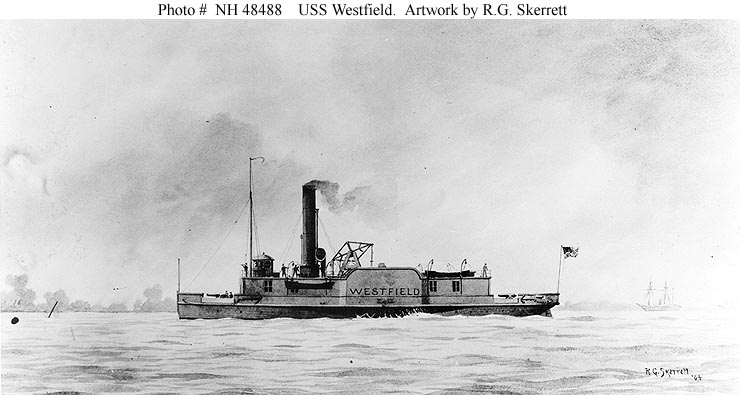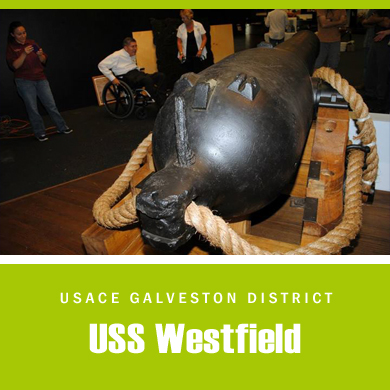
USS Westfield, an 822-ton side-wheel inshore gunboat, was built in 1861 at New York City as a civilian ferryboat. She was purchased by the Navy in November 1861 and placed in commission in January 1862. Sent to the Gulf of Mexico in February, Westfield took an active part in the April campaign to open the lower Mississippi River and capture New Orleans. During the following three months, the gunboat supported the mortar schooner flotilla in operations up the river toward Vicksburg. Sent to join the blockading force off Texas later in the summer of 1862, Westfield participated in the capture of Galveston in early October. She thereafter operated in that area. On 1 January 1863, while serving as flagship of the Federal naval forces off Galveston, she ran aground and was threatened by a daring Confederate attack. To prevent capture, USS Westfield was blown up by her crew.
 TEXAS CITY, Texas - Contractors working for the U.S. Army Corps of Engineers, Galveston District, discovered four cannonballs in the Texas City Ship Channel while performing dredging operations. The cannonballs were removed by the Federal Bureau of Investigation to be turned over to the U.S. Navy. Members of the U.S. Coast Guard's Marine Safety Unit Texas City assisted in the investigation. On Nov. 22, 2009, a 10,000-pound Dahlgren cannon was brought to the surface from the Texas City Channel by the Corps. The cannon was part of the USS Westfield, a Civil War-era gunboat blown up by its crew during the Battle of Galveston in 1863. Dredging efforts are part of a $71 million deepening project that will deepen nearly seven miles of the Texas City Ship channel from 40 feet to 45 feet. Larger vessels will be able to navigate the channel to provide products to the various industries as a result of this project.
TEXAS CITY, Texas - Contractors working for the U.S. Army Corps of Engineers, Galveston District, discovered four cannonballs in the Texas City Ship Channel while performing dredging operations. The cannonballs were removed by the Federal Bureau of Investigation to be turned over to the U.S. Navy. Members of the U.S. Coast Guard's Marine Safety Unit Texas City assisted in the investigation. On Nov. 22, 2009, a 10,000-pound Dahlgren cannon was brought to the surface from the Texas City Channel by the Corps. The cannon was part of the USS Westfield, a Civil War-era gunboat blown up by its crew during the Battle of Galveston in 1863. Dredging efforts are part of a $71 million deepening project that will deepen nearly seven miles of the Texas City Ship channel from 40 feet to 45 feet. Larger vessels will be able to navigate the channel to provide products to the various industries as a result of this project.
The restored cannon went on display at the Texas City Museum June 18, 2014. View photos of the restored cannon.